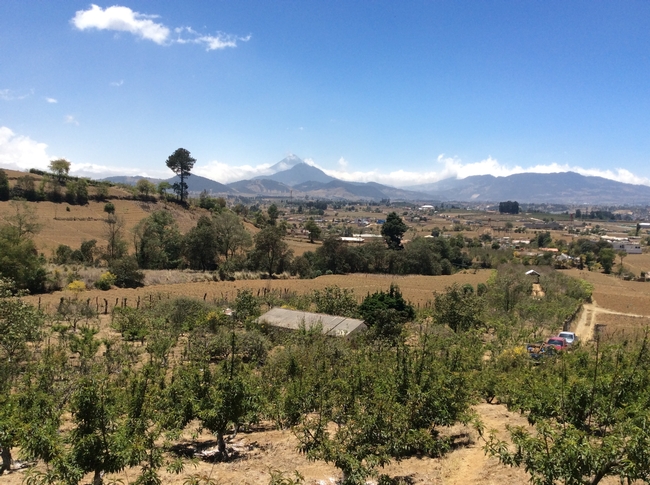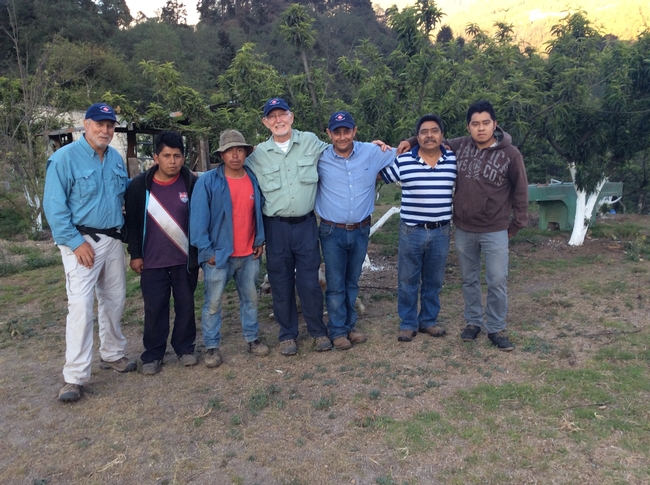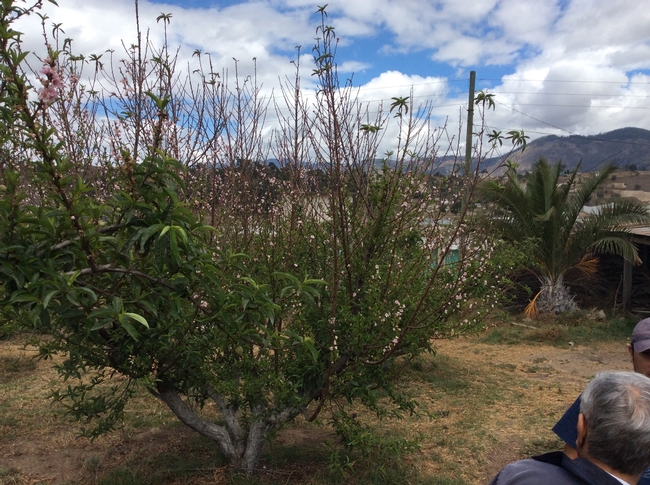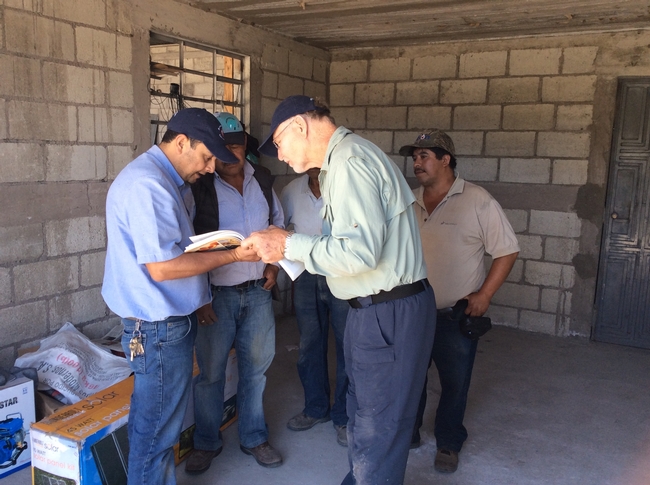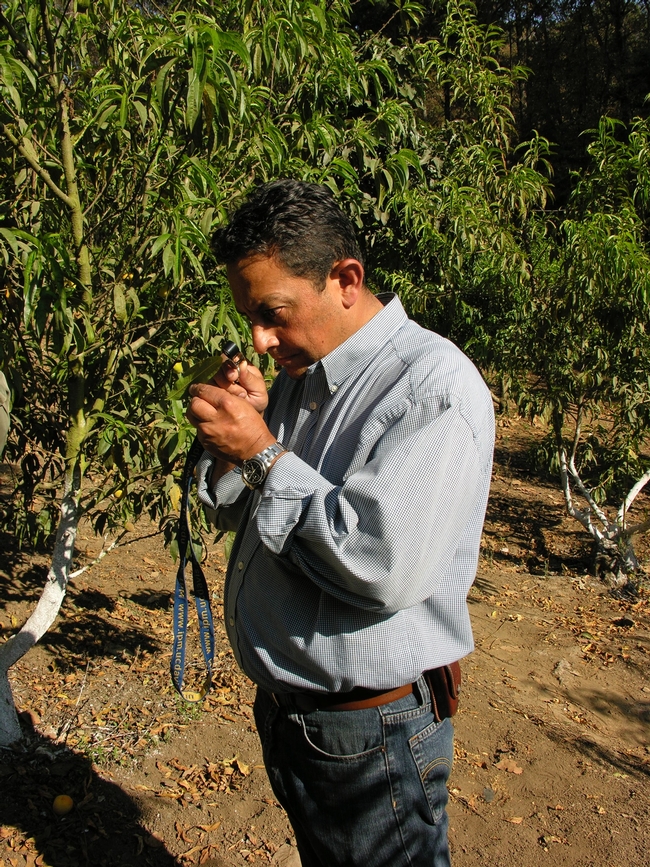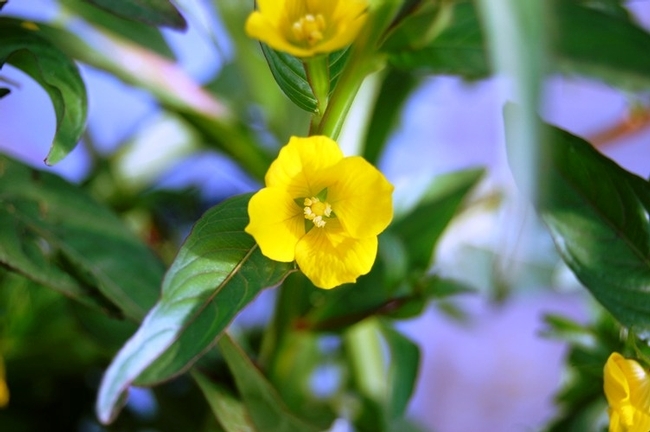Posts Tagged: Apples
IPM information extends to apple and peach growers in Guatemala
Did you know that apples and peaches are two important fruit crops planted in the highlands of Guatemala? More than 7,600 acres of apples and 6,100 acres of peaches are grown. However, with warm winters that don't allow for the winter chilling time that these crops require for optimal growth, and with freezing spring temperatures along with summer rains, growing apples and peaches in this area is often a challenge for growers.
As part of the Farmer-to-Farmer Program sponsored by the Partners of the Americas and funded by the United States Agency for International Development (USAID), retired UC IPM entomologist Walter Bentley and Washington State University entomologist Jay Brunner traveled to Guatemala in April to help growers improve the peach and apple industry. Their primary goal was to identify pest problems and possible solutions to help peach and apple growers improve fruit production, taking into account the region's unique climate.
“The most important issues were horticultural,” said Bentley. “The region's biggest need is for a horticulturist or plant pathologist.”
Some of the peach varieties require 300 to 500 chilling hours.
“Peach trees at elevations of 7,500 to 9,000 feet above sea level bloom for 2 months whereas bloom in California lasts just 10 days," he said. "You would get situations where the top half of the tree was in bloom while the bottom half was already producing fruit.”
This creates an environment favoring disease development and causing further problems for growers if the disease was severe enough to warrant a pesticide treatment. If a tree was partially in bloom while simultaneously producing fruit, it would have to be hand-sprayed multiple times so that the portion of the tree that warranted treatment was sprayed.
Although most of the important issues that Bentley and Brunner found were horticultural or disease-related, there were some insect problems. Many growers had stink bugs and other plant bugs attacking their trees. Spider mites and predatory mites were also observed. Growers sprayed pyrethroids after bloom to help prevent plant bug damage. However, applying pyrethroids reduced predatory mites, leading to an outbreak of spider mites.
After spending seven days touring four to six farms per day and looking at various practices, Bentley and Brunner spent the next week leading workshops for farmers and discussing integrated pest management (IPM) approaches to managing problems. Using the UC IPM website, specifically the Pest Management Guidelines for apples and peaches, Bentley and Brunner were able to teach sampling methods, stress the importance of correct pest identification, and encourage growers to spray with the least toxic and disruptive products. Bentley and Brunner were surprised by the large variety of pesticides available to growers, but were encouraged that farmers were willing to spray only when necessary while being open to other methods of control.
Both entomologists plan to keep the lines of communication open and feel the observations made during this trip could lead to future visits where sustainable pest management programs can be put into action. For example, predatory mites were observed in several of the orchards. This could lead to developing a biological control program to control spider mites.
Bentley and Brunner were impressed by the staff that took them around to each farm and by the growers who were receptive to new ways of managing pest problems. The farmers were very appreciative of the advice they received and were very generous. “Everywhere you went people wanted to share what they had,” said Bentley. “They are amazing people.”
Humbled by the experience, Bentley reflected, “I'm glad I went. I've been given a lot in my life and wanted to give back a little.”
An Apple from Your Pollinator
An apple a day may keep the doctor away, but thankfully, they don't keep our bees away. The blossoms, that is. We need those pollinators! During...

A honey bee pollinating an apple blossom. (Photo by Kathy Keatley Garvey)

Apples hanging from a tree. (Photo by Kathy Keatley Garvey)

The bounty--thanks to bees! (Photo by Kathy Keatley Garvey)
Inter-planting Fruit Trees With Veggies
Yes, you can have it all in a relatively small back yard space: Fruit trees and veggies. Our “mini orchard” is on an oblong plot that’s about 25x15’, a sunny plot that came with the house we bought last summer. In that space there are 3 dwarf plums (Prunus spp.), 2 apricots (P. armeniaca), 3 cherry trees (P. avium), 2 peach trees (P. persica), and an apple (Malus domestica), all of unknown varieties. Our fruit trees are about 5 or 6 year old mostly dwarfs (I think), and if not, they got dwarfed anyway by my pruning saw and loppers last December, when I pruned both for shape and fruit production. My rule of thumb with fruit trees is that if it is higher than I can reach, it gets lopped off. This permits easy picking of the fruit and avoids the need for ladders. The pruning and thinning of the foliage, which I do about once per month (see photos) also allows more nutrients to get to the fruit, besides giving those veggies planted in between their 6-8 hours of sun.
The veggies we have include 6 tomato plants (Solanum lycopersicum) in cages, 2 clumps of squashes (Curcurbita pepo), Japanese eggplant (Solanum melongena), bell peppers (Capsicum annuum), a lemon cucumber (Cucumis sativus), 3 hollyhocks (Alcea setosa), and 2 sunflowers (Helianthus annuus). The tomatoes have been so productive we have to give the surplus to neighbors and friends. The eggplant and peppers have been slower to mature but nonetheless very tasty in stir-fries, especially with added portabella mushrooms (Agaricus bisporus) and fresh chard (Beta vulgaris), the chard grown in one of our raised beds in another location of the yard.
And so, another example of when less (space) is more (more intensively gardened).
UC Davis has a publication called The California Backyard Orchard, which you may find useful for tips on pruning, both in the dormant season in during the spring and summer months. See homeorchard.ucdavis.edu.

Apricot. (photos by Bud Veliquette)
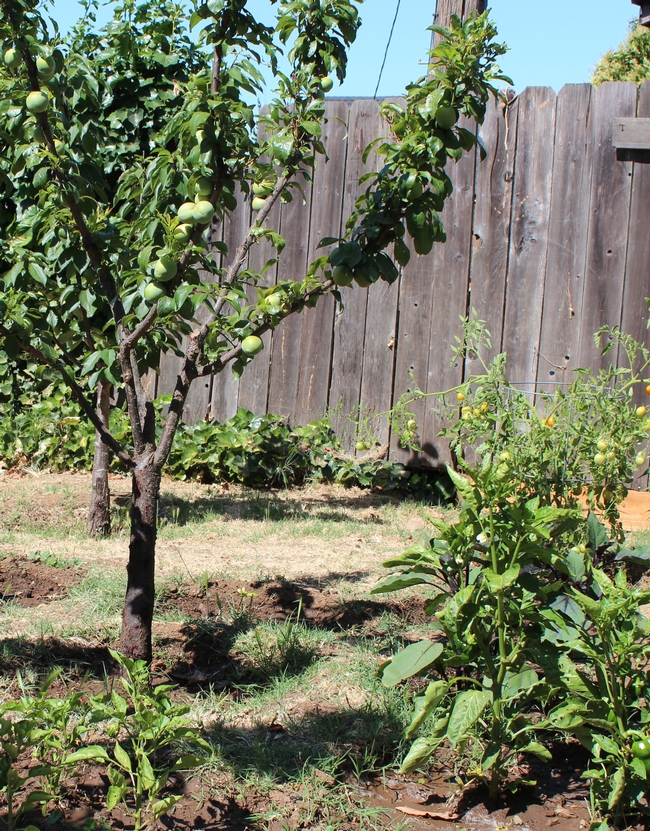
Apple tree, peppers and tomatoes.
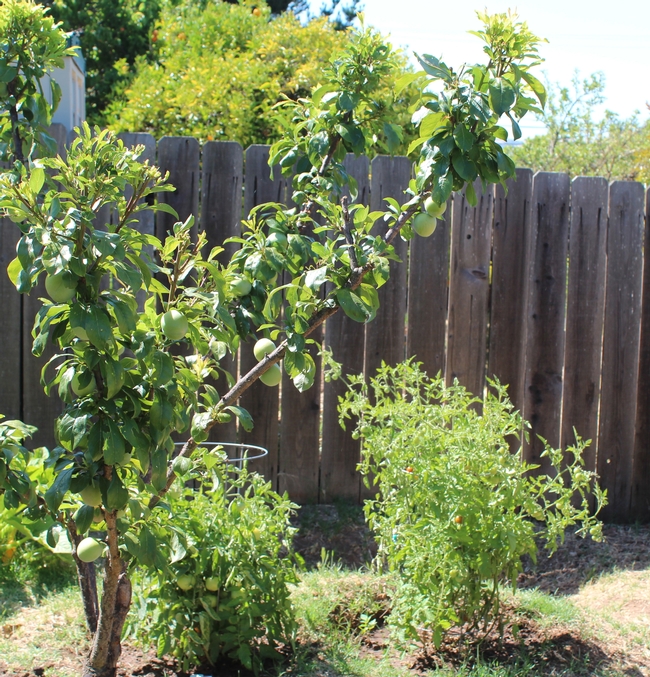
IMG 1082

Vine-ripening tomatoes.
The Inbetween Time
This is a time when the garden should be calling to me, because it’s that ‘in-between’ time, when the hills are golden–hued with crisping grasses and the ticks are nearly gone, and the apples are ready for picking. This year my crop of an as-yet-unidentified ‘Delicious’-type variety was bounteous, but since I did not protect against codling moth infestation, and I did not thin the crop, I have too many apples, many of them small, and many of them with an exit hole besmirched with frass. They are edible, but it’s simpler to just cut the apple in half and find the tunnel from the center and cut out the damage. I’ve never enjoyed the apples, but they are very flavorful this year.
With the winter rains about to start, I need to clean up the beds. This involves raking up dead leaves and fallen petals. I wish I could leave it to rot, and add organic material to my soil. But this cool, moist mulch would provide a wonderful cradle for fungal infections. The roses, hollyhocks and peach tree are particularly vulnerable. The roses are susceptible to black spot and rust, and the hollyhocks, which really don’t belong here in California (but I love their tall stalks and bunches of large open blossoms) develop rust so easily. Cleaning up fallen leaves is just plain sensible.
As for my peach tree, it is highly susceptible to peach leaf curl. I will clean up fallen leaves and I’ll be spraying the entire tree with a copper-based fungicide in early December, when all the leaves are gone. I’ll be mixing up a new batch (or rather my husband will…). Depending on what I can find, it will be a Bordeaux mixture, or an off-the-shelf product. Either way, I hope it will work. I’ll be replacing this tree in the next few years with a resistant variety, because it seems to be a never-ending battle, it is a very old tree and I do love peaches!
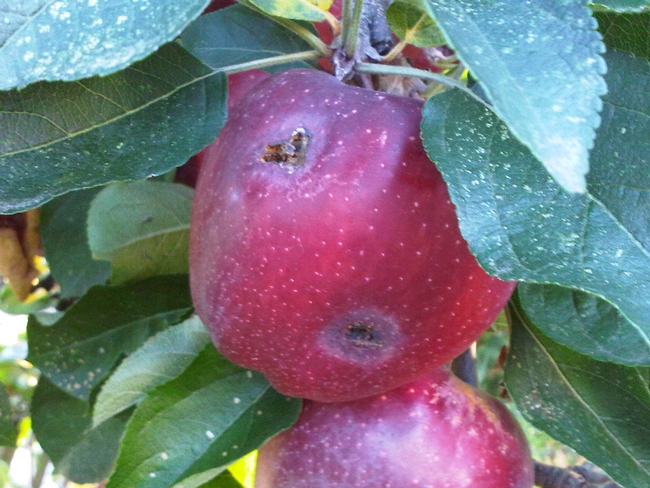
Apple hit with coddling moth. (photo by Riva Flexer)
Entomologists profiled in LA Times
Reporter Amina Khan with the LA Times profiled husband-and-wife entomologist team Christina and Mark Hoddle of UC Riverside (Mark is also a UC Cooperative Extension entomology specialist). The pair travel the world seeking parasitoids that can serve as biological control to invasive California pests and then test the results at the Center for Invasive Species Research at UC Riverside. "Bugs don't take weekends," Christina Hoddle told the reporter, "so neither do we."
Weed threatens rice-growing areas
Heather Hacking, Chico Enterprise Record
Photos and more details about the weed are also available from Luis Espino on the UC Rice Blog.
Autumn is for Apples: An Interview With Carol Fall
Jennifer Jewell, aNewsCafe.com
As apple season approaches, this article examines the Trinity Heritage Orchard Project through an interview of Carol Fall, program representative for UC Cooperative Extension Trinity County. The project has identified and mapped century-old apple trees from Gold Rush-era homesteads that are now on public lands and available for gleaning. Fall also evaluates how fruits of these heirloom varieties are best picked and used—whether for baking, cider-making, eating fresh or storing for winter months—and takes cuttings from the most significant varieties to plant elsewhere in the community. The article says Fall will provide apple samples Oct. 8 at Weaverville's annual Salmon Festival.


